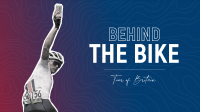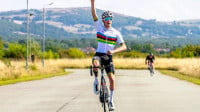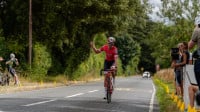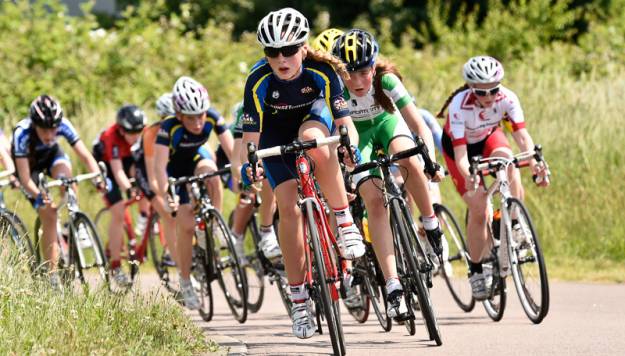Tour Watch
Stage 7 - Friday, July 10 2009: Barcelone - Andorre Arcalis 224 km| Results
Members Know Best: British Cycling's members know the sport better than anyone and we're inviting you to share your thoughts on this Tour de France - use the comments section at the bottom of this page, or email them to editor@britishcycling.org.uk
Climb Every Mountain
The first mountain stage of the Tour de France was a great spectacle and delivered all the drama and incident that we had been expecting.
A breakaway of nine riders dominated the battle to win the stage itself and also threw an unexpected spanner in the general classification spokes. Behind them, the leading contenders had their first eyeball-to-eyeball confrontation, with all the classic spaghetti western hard stares, quick draw attacks and a gimlet-eyed hero dispatching his foes up at the end. But would that hero be the Clint Eastwood of cycling, Lance Armstrong, or not?
Despite its great length, the stage was decided in the final kilometers of the climb to Arcalis in Andorra. The breakaway of eight began attacking each other from the bottom of the climb but their lead - at one time over 10 minutes - was rapidly dissolving by the mid-point.
Bradley Wiggins had a brilliant day in the mountains
Christophe Riblon was the main aggressor, but he finally ran out of steam and Tour debutant Brice Feillu of the Agritubel team was left to make the winning move, pulling clear and going on to win by five seconds from Christophe Kern of Cofidis. German Johannes Fröhlinger was third, with Rinaldo Nocentini fourth, just over 20 seconds down. Feillu's win was impressive, but the more significant result was actually that of Nocentini who, as much the best placed of the breakaway riders, suddenly found himself in with a great chance of ending the day in the yellow jersey. The time he'd put between himself and the leading contenders thundering up the road behind him would decide the issue.
The plot was thickening by the minute and the big stars were playing their parts to the full. The first real casualty on the climb was the yellow jersey wearer Fabian Cancellara. He hung in as long as he could, but finally blew as the Astana Team raised the pace.
With the early casualties out of the way, a smaller but high quality group of riders, including all the main contenders - Armstrong, Contador, the Schleck brother, Cadel Evans, Sastre, Menchov, Leipheimer, Kloden, Tony Martin and surprise package Bradley Wiggins - then set about each other with gusto.
Cadel Evans attacked with 1.7km to go and Armstrong and Contador smoothly countered along with Kloden. Evans noticeably pushing a high cadence, relaxed and waited for the next opportunity.
Alberto Contador was the next to go with Frank Schleck and Evans chasing him immediately, with Armstrong on their heels. However, Contador's attack was no simple testing of the water: he went hard and fast and totally committed and it was almost immediately apparent he was not going to be caught. The rest of the contenders fell back in some disarray and concentrated on limiting their losses. At the finish, Contador has 21 seconds over Cadel Evans who led the rest in, with only Kloden losing touch and a further 23 seconds.
It was a fine move by Contador. The other "stars" had no answer to his final acceleration and the young Spaniard must now be favourite to win the race overall. It was also an emphatic answer to Armstrong's questioning of his right to be leader of the Astana Team. The American put a brave spin on it in the post race interviews, saying it had been a good day for the team, but his grim expression told a deeper truth: he'd been unable to answer Contador's move. Clint had been outdrawn and wounded!
Contador gained enough time overturn Armstrong's overall advantage over him, but it just failed to put him ahead of Nocentini, who duly donned the yellow jersey at the stage finish. It was an intriguing sub-plot on a day when the story of this Tour really got going.
From a British point of view it was a superb day for Bradley Wiggins who played a full part in the action, leading the contenders' group up into the finish and completing the stage alongside some of the world's best climbers. Wiggins has worked hard for this result, shedding weight from his already very lean physique. He is determinedly working towards fulfilling his talent as a road rider for the first time and, with apologies to Chris Boardman, it was arguably the most convincing climbing performance by a British rider since the days of Robert Millar.
At the finish he was clearly excited by what he'd achieved: "I felt great on the climb. I'm trying not to get too excited. I've finally switched from being a world class trackie to being a road rider. My goal is top 20 on GC. I'll just keep plugging away. I'm in great shape, the form of my life."
Climbing - No Mystery, No Magic, Just Facts
One of the questions you see most often in the advice pages of cycling magazines is "how can I improve my climbing?" Answers cover a wide range of technical and not so technical solutions to this timeless cycling conundrum: get your riding position right; practice climbing; make sure your gearing is right; think positive; pace yourself; sort out your nutrition. All great advice, all helpful in one way or another, but all irrelevant in the face of the simple facts that it's all down to your power to weight ratio. The more power you put out the better. The lighter your weight, the better.
We can all accept that a car which weighs a ton and puts out 100 horse power will climb more slowly than a car of the same weight which puts out 150 horse power. Yet cyclists sometimes seem reluctant to acknowledge that their own climbing limitations are defined by their weight and by their conditioning. Lose weight and gain fitness and power and you climb better.
The best climbers combine a high sustainable power output with a relatively lightweight physique. Big men, like five time champion Miguel Indurain, who was over 6 feet tall and 12 stones in weight, can climb, but only by dint of their amazing power output.
Bradley Wiggins started this Tour lighter and fitter than ever before and the result is that he's climbing better than at any time in his career. Lance Armstrong came back from his cancer treatment less muscled in his upper body and several kilos lighter. He was therefore suddenly a contender in the high terrain where the race is won and lost.
Sadly, for all of us who dream of climbing like a Contador or and Armstrong, there is no magic solution and no mystery ingredient (we hope!). Climbing success is just a simple case of physics.









